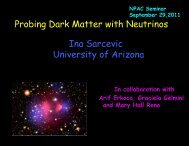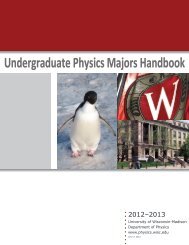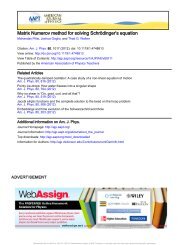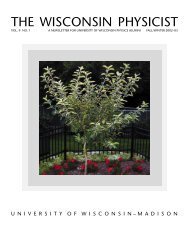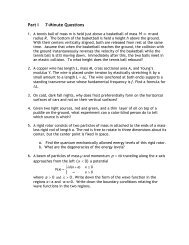T H E W I S C O N S I N P H Y S I C I S T - Department of Physics ...
T H E W I S C O N S I N P H Y S I C I S T - Department of Physics ...
T H E W I S C O N S I N P H Y S I C I S T - Department of Physics ...
Create successful ePaper yourself
Turn your PDF publications into a flip-book with our unique Google optimized e-Paper software.
UW GRAD IS STAR<br />
ON HER RETURN TO CAMPUS<br />
by Ron Seely, Wisconsin State Journal<br />
It’s a long jaunt from Lancaster to the universe’s most remote<br />
galaxies!<br />
But Anne Kinney, one <strong>of</strong> Lancaster’s own, now spends her<br />
days exploring the reaches <strong>of</strong> space for NASA. The UW-<br />
Madison <strong>Physics</strong> alum is director <strong>of</strong> the agency’s Astronomy<br />
and <strong>Physics</strong> division.<br />
Kinney was back on campus Friday to talk about NASA’s<br />
search for Earth-like planets and it’s study <strong>of</strong> black holessubjects<br />
that truly seem out <strong>of</strong> this world for somebody who<br />
grew up surrounded by farm fields and dairy cows in<br />
southwestern Wisconsin.<br />
Kinney spoke in the same Sterling Hall auditorium where she<br />
took her first college physics class. After graduating in 1975,<br />
Kinney went on to study at the Niels Bohr Institute in<br />
Denmark and got her doctorate in physics from New York<br />
University in 1984.<br />
Kinney, 54, was presented a Distinguished Alumni Award at<br />
the <strong>Physics</strong> <strong>Department</strong>’s annual banquet Friday night.<br />
During her career, Kinney said, she has been fortunate to<br />
work with three <strong>of</strong> history’s greatest observatories. Those<br />
include the Hubble Space Telescope, which has provided<br />
remarkable images <strong>of</strong> remote galaxies and distant star<br />
birthing regions, as well as two lesser known but equally<br />
important telescopes: the Spitzer Space Telescope, which<br />
takes infrared images, and the Chandra X-ray Observatory,<br />
which detects X-ray sources that are billions <strong>of</strong> light years<br />
away.<br />
Because the planets are lost in the bright glare <strong>of</strong> their suns,<br />
Kinney said, astronomers have discovered them by studying<br />
the movement <strong>of</strong> the suns as their planets’ gravitational pull<br />
tugs them back and forth. Now, Kinney said, astronomers are<br />
busy searching for smaller planets that might harbor life.<br />
Kinney is overseeing the construction and launch <strong>of</strong> a series<br />
<strong>of</strong> telescopes that will fly and work in tandem to give<br />
astronomers a powerful enough instrument to view a planet.<br />
Such science, Kinney predicted, will continue to be well<br />
funded even with President Bush’s recent proposal for<br />
manned exploration <strong>of</strong> Mars. A better understanding <strong>of</strong> space<br />
is essential to such exploration, Kinney said. She added that<br />
Hubble, which was once thought to be a victim <strong>of</strong> the Bush<br />
proposal, may now be saved if a robotic service mission can<br />
be designed.<br />
Why should we care about space and other planets?<br />
Kinney pointed out that astronomical discoveries <strong>of</strong>ten<br />
change how we view ourselves and our world. When Galileo<br />
took what had been an instrument <strong>of</strong> war - the telescope -<br />
and turned it toward the heavens, he saw the moons <strong>of</strong><br />
Jupiter. They seemed much like our own moon, and the<br />
discovery changed how we humans thought <strong>of</strong> ourselves and<br />
our world.<br />
So it would be, Kinney said, if we were to find another planet<br />
like our own.<br />
“There are pr<strong>of</strong>ound implications,” Kinney said. “In the end it<br />
will give us the context to really understand who we are.”<br />
Kinney is especially fond <strong>of</strong> Hubble. She worked as an<br />
instrument scientist at the Space Telescope Science Institute<br />
when the telescope was being built. She remembers working<br />
with the four-story tall telescope towering above her, shining<br />
in it’s Mylar sheath.<br />
Such instruments have revolutionized astronomy and made<br />
possible findings on the size and fate <strong>of</strong> the universe and the<br />
invisible, violent workings <strong>of</strong> black holes.<br />
“We really have an embarrassment <strong>of</strong> riches in astronomy<br />
right now,” Kinney said.<br />
Of special significance, Kinney said, has been recent work<br />
done by the agency on the discovery <strong>of</strong> Earth-like planets. It’s<br />
a booming field in astronomy, she added. Ten years ago, the<br />
only known planets were in our solar system. Today, we<br />
know <strong>of</strong> more than 100 large planets surrounding other stars.<br />
Anne Kinney<br />
20 U W – M A D I S O N P H Y S I C S


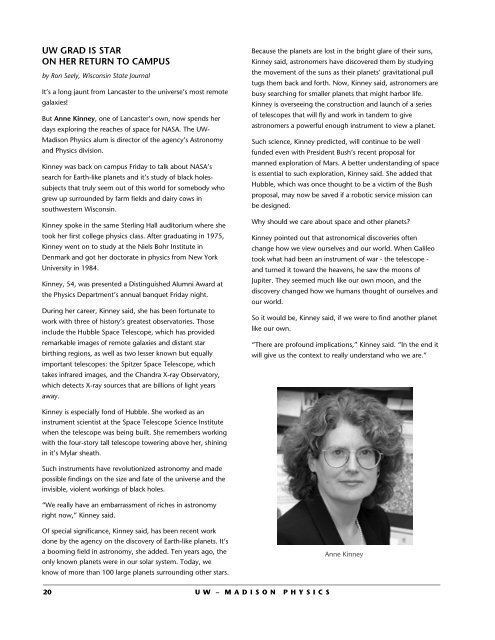

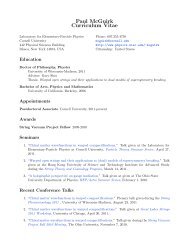
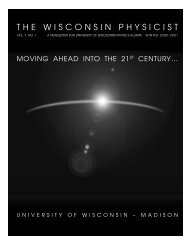
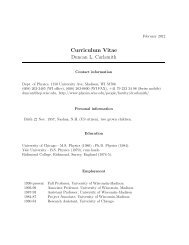
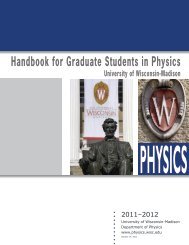


![The Symmetric Linear Potential [ ]](https://img.yumpu.com/25329322/1/190x245/the-symmetric-linear-potential-.jpg?quality=85)
